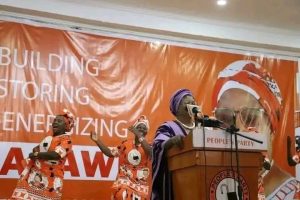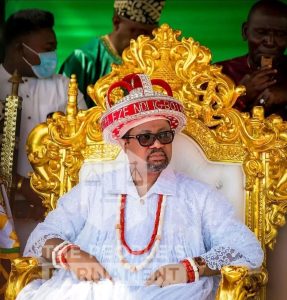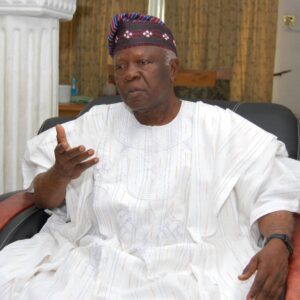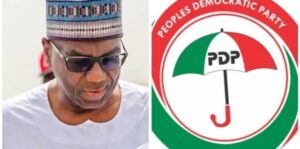CONSTITUTIONAL AMENDMENT: THE NEED TO TRANSFER RAILWAYS FROM THE EXCLUSIVE TO THE CONCURRENT LEGISLATIVE LIST
This Memorandum proposes that railways be moved from the Exclusive list to the Concurrent list of
the Constitution of the Federal Republic of Nigeria for the reasons set out herein.
The Constitution of the Federal Republic of Nigeria provides interalia under the second schedule,
sub- Legislative Powers Part I: Exclusive Legislative List, item 55, that Railways shall remain within
the exclusive legislative province of the National Assembly.
The import is that only the National Assembly can make laws for the initiation, construction,
operation and regulation of railways in Nigeria. In this regard, railway is deemed to include other
guided transportation systems such as metro, mono rail, rapid transit, trams and cable cars.
The “Concurrent Legislative List” in the constitution is the list of matters set out in the second
schedule of the Constitution with respect to which the National Assembly and a House of Assembly
may make laws to the extent prescribed.
A first question to ask is, what does the current provision serve, or better still, what does it
preserve? A simple answer is that it preserves the monopoly power of the Federal Government(FG)
and its agency, the Nigerian Railway Corporation (NRC). A Corporation that has been losing money
since 1964 and has gone bankrupt twice in its chequered history. A Corporation that is incapable of
meeting the competition and has continually lost market share from 60% at its peak to a now
derisory 1% of the transport market. A Corporation that consumes large amounts of public money
and empathy but consistently returns a piddling.
What one may ask are the benefits of transferring railways to the concurrent list? Perhaps a few will
suffice:
- To attract wider participation by sub-national governments and private entities to the sector.
- To increase the amount of investible funds available to the sector and expand the coverage of
railways across the country. - To enable contestable markets in a critical sector of the economy and to act as a catalyst for
economic development and growth. - The current provision is being observed in the breach and hence has been overtaken by events.
2
It has been argued that all of the above are achievable under the current constitutional
arrangements and that it’s just that the political will has been historically lacking. This same untruth
has been peddled in defence of the status quo for as long as one can remember and every
government appears to have bought into this narrative and ploughed more money into the railways
yet repeatedly producing the same unsatisfactory results.
On the other hand, the restriction of the participatory space has left the FG as the sole investor in
the railway sector and its lack of capacity shows through in its results. A sector which requires a
significant amount of investment and entrepreneurial flare should have the inputs from the widest
array of credible interests available to it. This it will get from opening the space to wider
participation.
The Nigerian Railways was created in 1912 with the merger of the Lagos Government Railways and
the Baro-Kano Railways. It became an autonomous public corporation created by the Nigerian
Railway Corporation Act (1955) with the objective of “the carriage of passengers and goods in the
manner that will offer full value and quality of service, ensure safety of operations and maximum
efficiency, meet social responsibility in a manner that will meet the requirements of rail users, trade,
commerce and the general public’’. In essence the enabling Act provides for the conduct of a viable
and sustainable railway business by the corporation.
Sadly, the NRC has been unable to live up to its enabling Act. It’s fortunes went into steep decline
very early in the 1960s and 1970s and it stopped recovering its operating costs from as far back as
1964. By 1978, revenue covered only 40% of the operating costs and by 2004, this was down to 14%.
Indeed rental income from its extensive property holdings exceeded revenue from its operations.
The NRC had become a glorified property holding! As at today, its operating ratio hovers around
23%. In essence, the NRC has been unsustainable as a business since 1964. It needs investment and
human capacity development to thrive. The FG alone is incapable of providing it. It needs a different
approach.
In 2003, NRC revenues were nearly N600m on the back of expenses of N3bn with an operating ratio
of 20%. The Corporation was virtually bankrupt again spending as much as N5 for every N1 of
revenue earned. In 2003 and 2004 the FG provided the NRC with subsidies of N3.9bn and N1.6bn
respectively and its ballooning debt profile was now in excess of N10bn.
As at July 2006, the NRC’s facilities were in such a state of dilapidation due to the lack of
maintenance and spares that only 13 of its 225 locomotives were in serviceable condition and even
3
those that were available could not be deployed for reasons as mundane as lack of working capital
to purchase fuel.
Since 2009, when the NRC embarked on its recent wave of capital spending, rehabilitating and
building new infrastructure, acquiring new locomotives and operations and maintenance assets, its
results have remained uninspiring. In 2010, it reported 139,000 tons of freight hauled and 1.5m
passengers. In 2011, it reported 340,000 tons of freight and 3.4m passengers. In 2012, it reported
180,000 tons of freight and 4.3m passengers. In 2013, freight hauled was 100,000 tons and 4.5m
passengers. In 2014, it reported freight hauled as 211,000 tons and 4.7m passengers.
Railway has not played its natural role in the transportation sector of the Nigerian economy for a
long time since fixed and operations infrastructure fell into dilapidation.
Locomotive availability of NRC as at 2010 was dismal at 6 % in comparison to locomotive availability
percentage of about 75% in Africa and 85-90% in more efficiently managed railways elsewhere. The
availability of wagons (28 %) and passenger coaches (29 %) was also low in comparison to
international standards of 95% and 90% respectively. The traffic hauled even declined to less than
50,000 tons of freight and about one million passengers per year from 3.0 million tons of freight and
15 million passengers per year in 1984.
It is caught in the proverbial conflict of needing to grow to seize market opportunities but its
capacity to fund and manage growth not burdened by a cumbersome government administrative
and regulatory system and its own conflicts of interest in operations and regulation hinder its
performance.
In 2015, freight hauled was reported as 243,000 tons while passengers ferried were 2.6m. In 2016,
freight was 103,000 tons and passengers were 3.2m. In 2017, freight was 141,000 tons whereas
5,000
10,000
15,000
20,000
1964
1966
1968
1970
1972
1974
1976
1978
1980
1982
1984
1986
1988
1990
1992
1994
1996
1998
2000
2002
2004
2006
2008
2010
2012
2014
2016
2018
‘000 passengers
Year
NRC Passenger
4
passengers ferried were 2.6m and in 2018, freight was 329,000 tons while passengers were about
3m.
If these results tell us anything, it is that the NRC is continuing to lose money hand over fist. In the
last 10 years, its best relative performance was in 2014 for passengers of 4.7m and 2011 for freight
of 341,000 tons. This sadly compares starkly with 1984 of 15m passengers and 3m tons of freight in
1964. In the last 10 years, its personnel costs have more than doubled from N2.4bn in 2009 to about
N7bn in 2019. Yet its performance has remained uninspired. What makes these comparisons all the
more galling is that the growth in traffic volumes nationally have been astronomical and gone on the
roads. Instead the trajectory for rail has been downwards.
As at today, the NRC remains practically insolvent spending about N3-5 to earn N1. Without the
feeding bottle from the FG, it will shut down. It does not appear to understand its business nor its
markets. It cannot compete with the roads sector which is privately run. It’s potentially profitable
freight business which underpins railway viability and sustainability has continually remained in
decline while its focus appears to be on its loss making passenger business which is coasting at the
bottom of the chart regardless of how much public money is supposedly ploughed into the sector.
This is clearly a paradox.
The railways are an integral part of the logistics chain. It competes with and compliments the other
modes of transportation. It is energy efficient and provides key economic benefits in enabling
mobility and public safety in the movement particularly of freight over medium to long distances and
loose cargoes such as mining products over short distances.
1,000
2,000
3,000
4,000
5,000
1964
1966
1968
1970
1972
1974
1976
1978
1980
1982
1984
1986
1988
1990
1992
1994
1996
1998
2000
2002
2004
2006
2008
2010
2012
2014
2016
2018
‘000 MT
Year
NRC Freight
5
A weakness in the traditional methods of providing transport facilities and services has been the
absence of a structure of incentives that align the interests of the supplier with the needs of the
consumers. It is now widely accepted that one of the most powerful ways to force suppliers to
respond to the requirements of consumers in competitive markets is the potential loss of
patronage. Indeed, Michael Beesley, one of the leading architects of the British system of utility
regulation, argued that competition is the most important mechanism for limiting monopoly power
and optimising consumer benefits.
It’s essence is in competitive rivalry and the freedom to enter and exit a market. Competition serves
the public interest when it induces suppliers to greater efficiency and offer more choice to
consumers at competitive prices. When there is competition in a market-based economy, different
suppliers compete against each other to offer their goods or services to consumers. These are the
lessons that the NRC is unable to learn.
Competitive suppliers may offer lower prices, more or better quality of service to attract customers.
In a competitive market, individual suppliers lack “market power” as they cannot dictate market
terms, but must respond to the rivalry of the competition to stay in business. The threat of rivalry
from other suppliers enhances the contestability of a market across all its dimensions including –
price, quality and innovation. So the goal of competition policy should be to promote, protect and
preserve competition as the most appropriate means of ensuring the efficient allocation of
resources.
As a result, the railway industry in many countries, have undertaken a range of reforms to open
them up to competition. These reforms may involve introducing competition and private
participation in finance, operation, management and sometimes, the ownership of the railways.
Indeed, the railway industry in some countries have now been transformed from a poorly managed
public utility with mounting financial losses to an efficient market driven industry with a more
commercial outlook.
Many reasons have been adduced for the failure of state owned railway systems across the world.
Some of these include:
o Inappropriate Interventions – where Governments, for example, have sometimes
imposed unsustainable fare and service conditions, overestimating what can be
accommodated through internal cross subsidy.
6
o Excessive Operating Costs – Emerging from either over-staffing, operational inefficiency,
and/or poorly targeted capital investment. Also unfair competitive terms where,
railways are made to bear track and infrastructure costs whereas other operators in say
roads don’t have similar obligations.
o Obtuse Incentives – where, for example, entry to the rail sector is restricted, fares and
freight charges may be controlled to limit the rate of return on capital. This could lead to
the “padding out” of costs through excessive capitalization; a reluctance to pool
resources such as terminals or to lease facilities; the use of perhaps costlier equipment
and earlier vehicle replacement than a competitive market would ordinarily permit; and,
excessive vertical integration.
o Absence of Dynamism – strict entry regulation limiting the provision of cheaper rail
transportation which meets the transport demands of poorer groups or more expensive
alternatives targeting richer consumers.
o Regional development policies and subsidies to internal commodity markets have
sometimes been effected through rail prices which may diminish the competitive
advantage of the railways and undermine its financial viability.
Furthermore, social obligations to staff may make it nearly impossible to achieve agreement on
redundancies or even wage adjustments. In certain environments, deficits were financed by
borrowing and finances were completely skewed. As a consequence state-owned railways are now
widely regarded to have failed.
It is argued that the best way to align consumer needs and demand, with the provision of railway
services, in a manner which promotes economic and financial sustainability is through competition.
Many policymakers in several countries have concluded, that the solution to the railway
sustainability problem is to be found in creating a competitive railway industry.
Available evidence may suggest that substantial cost savings can be achieved by creating
competition and private participation in the supply of the railway infrastructure facilities and train
services. Many countries have therefore embarked on economic reforms aimed at creating a
competitive market-based transport industry.
7
The Nigerian Railway Corporation is a public enterprise as defined by the Public Enterprises
(Privatisation and Commercialisation) Decree No. 28 promulgated under the government of
Abdulsalam Abubakar in early 1999 before it handed over to the Obasanjo government. The Decree
initiated the second phase of the privatisation exercise under the Bureau for Public Enterprises
(BPE).
It allowed the BPE to alter, add, delete or amend the provisions in the document in the best interest
of the country. Initially sixty-one (61) enterprises were slated for privatisation (36 partial and 25 full
privatisation) but this was increased by an additional 37 enterprises (some of which were originally
meant for commercialisation). Some of the big government companies slated for privatisation
included National Insurance Corporation of Nigeria (NICON), Nigerian Re-insurance Corporation,
Nigerdock Plc, National Aviation Handling Company (NAHCO), Nigeria Railways Corporation (NRC),
Nigerian Ports Authority (NPA), Nigerian Postal Services (NIPOST) and Savannah Sugar Company
among others.
At an Investment forum in London in 2001 to drum up support for the privatisation of the public
enterprises, the then Director General of the Bureau of Public Enterprises (BPE) now Governor of
Kaduna State, Nasir el-Rufai, outlined that as at the end of the year 2000, Nigeria had 590 public
enterprises of which 160 could be described as involved in economic activities. The public
enterprises were managed through boards of directors involving over 5,000 board appointments
suggesting enormous patronage power for the appointing government. They also controlled funds
that at the time, of over N1 trillion, were in excess of the Federal Budget. They were also involved in
transfers of about $4bn in 2001 and accounted for a budget deficit of 5% of GDP as at 1998, which
was growing.
55% of the non performing debts owed to the London and Paris Clubs were public enterprise debts
and most of the public enterprises were operating sub-optimally and were among the most
inefficient in the world citing NRC(Railways), NEPA(Power), NITEL(Telecoms), NPA (Ports), NNSL
(Shipping), NAL(Aviation), IWOPIN (Paper Mills), ASCL & DSC (Steel), Bacita (Sugar) as particular
culprits.
The BPE DG advised the forum that “no government business in Nigeria makes true profit today –
and none has ever ever made real profit unless managed by Technical Partners (the NITEL, Nigerdock
and NAFCON stories)”. That the objectives for the establishment of public enterprises which
included, balancing or replacing a weak private sector, control of the commanding heights or
strategic sectors of the economy, production of higher investment ratios, achieving technology
8
transfers and of management know-how, generating employment, developing otherwise
uneconomic areas or sectors and providing goods and services at lower costs, had largely been
unachieved.
That these public enterprises collectively returned 0.5% profit and employed about 420,000 people,
and without NICON Insurance and the Central Bank of Nigeria, the returns were negative. That there
was clear evidence that public enterprises had not served their customers, employees, shareholders
nor the Nigerian tax payers.
That the public enterprises had instead become a reverse “Robin Hood” who were robbing the poor
to serve the rich as they served as platforms for political patronage and the promotion of short-term
political objectives to the longer term detriment of Nigeria and Nigerians. They also provided an
infrastructure of corruption, parasitism and rent-seeking for the elite, consumed an average of $3bn
annually in subsidies during 1992-99 and constituted major stumbling blocks to obtaining debt relief
for the country.
Thus the BPE made the case for privatizing public enterprises based on apparently clear evidence
that the enterprises had contributed to Nigeria’s economic stagnation and poor image. That the
enterprises had created economic inefficiency, consistently incurred financial losses, absorbed
disproportionate share of credit, contributed to fiscal deficits and imbalances, facilitated and
entrenched parasitism and corruption, and attracted rapacious military-civilian elites to politics.
Whereas NITEL has now been sold off and NEPA restructured and privatised albeit controversially,
the NRC has remained intact and carried on the business of poor service and waste.
The mandate of the Federal Ministry of Transportation is to formulate and ensure the
implementation of Government policies for effective and efficient transport systems in Nigeria, set
guidelines on transportation for stakeholders, provide infrastructure for the maritime sub-sector,
develop skilled manpower in the transport sector, ensure the maintenance of security and safety
standards in the transport industry with special reference to maritime, inland waterways, land
(railway), and aviation transportation and also relates with international organisations on matters
affecting the entire transport sector. The Federal Ministry of Transportation has a number of
parastatals and agencies through which Government policies are implemented. For the railways, this
is the Nigerian Railway Corporation (NRC).
The Nigerian Railway Corporation is established by the Nigerian Railway Corporation Act which
provides in Section 5 that:
9
“The Corporation shall consist of the following members-
(a) A chairman who shall be appointed by the Minister;
(b) Twenty – six other members, to be appointed by the Minister, of whom –
(i) One shall be a person appearing to the Minister to be qualified academically and
practically in industrial relations;
(ii) One shall be a person appearing to the Minister to be qualified to represent
commercial interest in Nigeria;
(iii) Twenty-two shall be persons appearing to the Minister to have had experience in
commerce and in the use of railway transport, each of whom shall have been
recommended by the Governor as representing a State and by the “appropriate
Minister” as representing the Federal Capital Territory, Abuja.
(iv) One shall be a person appearing to the Minister to be qualified to represent the
Nigerian Ports Authority.
(c) The general manager of the Corporation appointed in accordance with the provisions of
section 10 of this Act, who shall be an ex-officio member of the Corporation but shall have
no right to vote at any meeting of the Corporation, or on any question falling to be decided
at such meeting.”
Section 10 sub. (2) provides that:
“The general manager shall be appointed by the Corporation and shall be a person appearing
to the chairman to have had wide experience of railway management.”
Section 15 sub. (1) provides that:
“It shall be the duty of the Corporation to –
(a) manage and operate, in accordance with the provisions of this Act, the railway undertaking
transferred to the Corporation by virtue of the provisions of this Act and any expansions or
extensions thereof and any new railway and to provide all reasonable facilities for carriage
by the Corporation of passengers and goods:
Provided that the Corporation shall not be under any obligation to continue or introduce any
particular service or facility which is uneconomic, or which appears to the Corporation to be
unlikely to provide within a reasonable time, adequate revenue to meet the cost of the
Corporation of providing that service or facility, unless the Minister so directs, in which event
the Corporation may be reimbursed from the public revenue of the Federation, the amount
by which it is proved to the satisfaction of the Minister that the revenue received from the
service or facility in respect of any financial year is less than the amount of the charges
10
properly chargeable to revenue in respect of that year and attributed to that service or
facility;
(b) control the expenditure of the Corporation, whether on revenue or capital account;
(c) conduct the affairs of the Corporation as to ensure that so far as practicable, the annual
revenue of the Corporation are, taking one financial year with another, sufficient to meet all
charges properly chargeable to revenue; and
(d) direct and control any extension of the railway and the construction of any new railway.”
Section 29 provides that:
“It shall be unlawful for any person, without the consent of the Corporation, to construct or
operate a railway for the public carriage of passengers or goods within Nigeria”
Section 28 provides that:
Notwithstanding anything hereinbefore in this Part contained, no extension of the route
mileage of a railway, shall be undertaken by or on behalf of the Corporation, without the
prior sanction of the Minister, if such extension-
(a) exceeds 8.0465 kilometres in length; and
(b) is intended for the public carriage of passengers,
and no extension exceeding 8.0465 kilometres in length of the route mileage of a railway,
shall be used for the public carriage of passengers, without such sanction as aforesaid.”
The Statutory Corporations (Modifications, Etc) Act amends the NRC Act and re-designates the
General Manager(GM) of the Nigerian Railway Corporation as Managing Director (MD) and a full
member of the Corporation but not as Chairman. This has long been adopted and the GM has
become known as the MD.
The Statutory Corporations, etc (Special Provisions) Act also amends the NRC Act and limits
membership of the Corporation to a Chairman and no more than 8 other members, and without
derogating from that number, there may be ex-officio members which at any one time shall not
exceed 5 in number. That means that the NRC Board should be no more than 14 persons. Instead, it
currently has about 24 members which is clearly in violation of the law.
Whereas, the provisions of the Nigerian Railway Corporation Act are quite clear that no one should
be awarding or superintending contracts for the construction of railways. That duty is the exclusive
preserve of the Nigerian Railway Corporation (NRC). Against the letter and spirit of the railway law,
the Federal Ministry of Transportation continues to award and superintend very large contracts for
11
the construction of railway infrastructure. It is responsible for the $8.3bn Lagos – Kano standard
gauge contract awarded in October 2006 which is now being implemented in phases. It also
awarded a $12bn contract for the Coastal Railway line, to build a standard gauge line from Lagos to
Calabar, in December 2014 for a duration of 6 years. It also awarded in 2009, a N33.3 bn contract for
the rehabilitation and completion of the Warri – Itakpe standard gauge line for 3 years. It has
awarded a contract to construct a railway from Abuja to Itakpe as well as from Kano to Maradi in
Niger Republic.
Indeed the contract for the Warri – Itakpe standard gauge line was initially awarded by the Federal
Ministry of Mines and Power before it was transferred to the Federal Ministry of Transport (FMT) by
Yar’Adua in 2008. The Lagos – Kano modernisation contract was awarded by the Federal Ministry of
Transport but was initially domiciled in the Office of the Secretary to the Government of the
Federation (OSGF). Whereas neither the OSGF nor the FMT can nor has demonstrated the technical
capacity to effectively manage and deliver such highly complex and specialised endeavours. The first
question that comes to mind is, what technical competences could the FMT have over the NRC that
makes it better placed to manage such undertakings? The mind really boggles as to why the
Government acts as if it is not aware of the constitutional constraints on its action or as if it is not
seized of appropriate legal counsel as to the implications of some of its actions. Indeed is it any
surprise that the NRC flounders and lacks capacity when its responsibilities are routinely usurped by
others more powerful?
The Board of the NRC is synonymous with the Corporation in the eye of the law. The effect of a
dissolution of the Board and the non-constitution of a new Board immediately is tantamount to a
dissolution of the Corporation and is illegal. This has been done repeatedly in the past and without
consequence.
What is evident is that the Government is violating the laws it is supposed to uphold while the
Legislature looks the other way. The size of the current NRC Board violates the law. The NRC most
recently operated for nearly 4 years without a Board, again clearly in violation of the law. The FMT is
still awarding railway contracts against the law. That the Minister has the power to appoint the
Board does not give him the power to usurp its powers. Our institutions are crumbling because
strong men continue to undermine them.
The question to ask the National Assembly is, why do we have laws if they would be disobeyed by
the Government which is to enforce them? Indeed, if the Government is not happy with the law,
12
why not amend them? Why do you keep laws on the statute books and breach them with such rank
impunity?
In 2015, the FG finally sent the Nigerian Railway Authority and National Transport Commission bills
among other transport sector reform bills to the National Assembly for consideration. The bills had
taken about 15 years to make the journey to the legislature from the executive. The NRA bill
proposes to repeal the existing NRC Act and restructures the railway environment. It separates
policy formulation which it vests in the Minister from Operations which it vests in the Corporation or
Agency and regulation which it vests in an independent Agency. It also enabled wider participation
in the railway by the private sector and sub-national governments. The NTC bill on the other hand
creates an independent multi sectoral regulator for the transport sector. Whereas the NTC bill was
passed by the National Assembly and awaits presidential assent. The NRA bill was passed by the
Senate while it reached third reading in the House of Representatives. There is therefore no doubt
that the principle of reform and restructuring for the railways has been endorsed by the National
Assembly as well as the executive arm of government.
In 2016, the FG embarked on a belated attempt to concession the narrow gauge network to a multi-
national consortium led by an American private sector conglomerate to invest, rehabilitate, operate
and maintain the network. This effort failed for a number of reasons but cannot be cited as an
example of the unwillingness of the private sector to invest in the sector. Principally, it failed
because the NRC and the railway environment had not been prior reformed and restructured.
A situation where the Lagos State agency LAMATA or other sub-national government obtains
delegated authority from the NRC in order for it to construct, operate and regulate its metro does
not encourage investment and may be one reason why the project has not gained traction among
other reasons. A private investor may take a look at the NRC and wonder if it has the capacity to
regulate urban metros. It will question how robust the interface between the NRC and LAMATA is. It
will wonder whether it should commit its billions of dollars as investment in these circumstances.
Whereas concurrent legislative powers will have the greater impetus and imprimatur especially in
the area of urban metros. Lagos, Port Harcourt and Kano are candidates for metros as they are cities
with populations in excess of 6m.
LAMATA will likely make a better regulator for the Lagos RMT rather than the NRC. It will learn and
build robust regulatory capacity. That there will be a synergy in the two working in harmony there is
no doubt and it is the same principle that enables the National Assembly and the State Houses of
13
Assembly to work synergetically to enact laws for the good governance for one and all. Not as one
that is subordinate to the other but as partners in progress.
The NRC operates and regulates the Abuja RMT. A role that it lacks the capacity to play but that is
what the law says. Suffice, it is conflicted as well. So far, the impact of the Abuja RMT to
transportation in the FCT is about zero. Abuja needs its own Transit Authority empowered by laws
made by the National Assembly.
The sum total of the evidence laid here is the need for urgent reform and a restructuring of the
railway sector. Whereas the FG has in principle accepted of the need for the railway environment to
be reformed and restructured. It has demonstrated this resolve by some of its actions since 1998 to
date. Sadly as it takes one gingerly step forward, an invisible hand appears to force it to take several
more backward.
It is time to seize the bull by the horn and to make definitive progress towards breathing new life
into the railway sector. The important first step in opening up the railway sector to broader
participation is in reform and restructuring. That first step of firsts is in transferring the railways from
the exclusive list to the concurrent list.
I commend this proposal to the Senate and wish you the best.
May God bless us all.
Rowland Ataguba 14 September 2020
Managing Director
Bethlehem Rail Infrastructure Limited
London NW7 4RS








